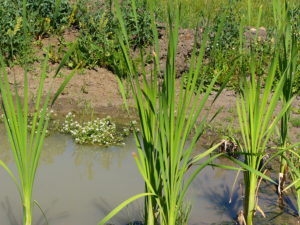Cattail, or Bulrush (Typha latifolia): kwtállp (E);
mat made from cattail or bulrush: cnel’epten
 Mary Thomas recalled that at the mouth of the Salmon River the cattails were so tall, you couldn’t see the top of the heads of grown men over them, and noted that the bulrush feeds on pollutants; it’s like a sponge and helps purify the water where it grows (Helping Nature Heal conference speech). Cattail rhizomes are starchy and edible, and the young shoots and young flower spikes, too, are edible raw or cooked. The Secwepemc people apparently ate cattail rhizomes, but probably very little, at least within the last 70 years or so. Few people recall the details of their use, but they were said to have been boiled or eaten raw, and were also dried and made into flour. Cattail is the one with the distinctive, brown seedheads, and clusters of flattened, spongy leaves. The seed fluff of the cattail was used for stuffing more mattresses and pillows. It was harvested in late summer, fall and even in winter, when one can walk out over the ice to gather it. This material also makes good diapering for baby cradles. The long, spongy leaves were used for many purposes, especially for making mats, which were then used as mattresses, doorway coverings, canoe liners, and for wrapping food and drying berries and other food on. They were also used to make summer shelters, which wouldn’t leak if done properly. The leaves were gathered (“made”) in the fall, tied in bundles, and taken back for processing. They were also used as a covering for salmon drying racks and to make a smokehouse. According to Teit (1909:534) “mats woven of rushes, were used as saddle blankets.” Mats were made by laying the leaves out side by side alternating top and bottom, and threading them together transversely at about 10 cm (4-in.) intervals using a fibre such as Indian-hemp twine, or the lower edge of the cattail leaf itself. The leaves could also be twined together with these materials. Mats made from cattail can be 2 m (6ft) long or longer, and are very efficient, because they are light weight and can be rolled up and carried easily from place to place. Cattails were highly important as habitat for many types of birds, including blackbirds, bluebirds, grebes, coots and mallard ducks, as well as muskrat and other mammals.
Mary Thomas recalled that at the mouth of the Salmon River the cattails were so tall, you couldn’t see the top of the heads of grown men over them, and noted that the bulrush feeds on pollutants; it’s like a sponge and helps purify the water where it grows (Helping Nature Heal conference speech). Cattail rhizomes are starchy and edible, and the young shoots and young flower spikes, too, are edible raw or cooked. The Secwepemc people apparently ate cattail rhizomes, but probably very little, at least within the last 70 years or so. Few people recall the details of their use, but they were said to have been boiled or eaten raw, and were also dried and made into flour. Cattail is the one with the distinctive, brown seedheads, and clusters of flattened, spongy leaves. The seed fluff of the cattail was used for stuffing more mattresses and pillows. It was harvested in late summer, fall and even in winter, when one can walk out over the ice to gather it. This material also makes good diapering for baby cradles. The long, spongy leaves were used for many purposes, especially for making mats, which were then used as mattresses, doorway coverings, canoe liners, and for wrapping food and drying berries and other food on. They were also used to make summer shelters, which wouldn’t leak if done properly. The leaves were gathered (“made”) in the fall, tied in bundles, and taken back for processing. They were also used as a covering for salmon drying racks and to make a smokehouse. According to Teit (1909:534) “mats woven of rushes, were used as saddle blankets.” Mats were made by laying the leaves out side by side alternating top and bottom, and threading them together transversely at about 10 cm (4-in.) intervals using a fibre such as Indian-hemp twine, or the lower edge of the cattail leaf itself. The leaves could also be twined together with these materials. Mats made from cattail can be 2 m (6ft) long or longer, and are very efficient, because they are light weight and can be rolled up and carried easily from place to place. Cattails were highly important as habitat for many types of birds, including blackbirds, bluebirds, grebes, coots and mallard ducks, as well as muskrat and other mammals.
Taken with permission from Culturally important plants of the Salmon River Delta and Floodplain
![]()
